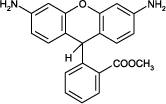Replaces Prod. #: ALX-610-021
Dihydrorhodamine 123 is a widely utilized probe for detection of intracellular reactive oxygen species (ROS) such as peroxide, hypochlorous acid and peroxynitrite. It is readily oxidized into rhodamine 123, which exhibits a spectral profile similar to that of FITC. In combination with other fluorescent probes (such as surface receptor-targeted fluorescent antibodies, the cell viability probe propidium iodide, or fluorescent calcium indicators) dihydrorhodamine 123 can be used for multiparametric cell measurements. Wavelength Maxima: Excitation 507nm, Emission 529nm
Product Details
| Alternative Name: | 2-(3,6-Diamino-9H-xanthene-9-yl)-benzoic acid methyl ester |
| |
| MW: | 346.4 |
| |
| CAS: | 109244-58-8 |
| |
| Purity: | ≥95% (HPLC) |
| |
| Solubility: | Soluble in DMSO. |
| |
| Shipping: | Ambient Temperature |
| |
| Long Term Storage: | -20°C |
| |
| Use/Stability: | Stable for at least one year after receipt when stored as recommended. |
| |
| Handling: | Protect from light. Keep cool and dry. |
| |
| Technical Info/Product Notes: | This product is a member of the CELLESTIAL® product line, reagents and assay kits comprising fluorescent molecular probes that have been extensively benchmarked for live cell analysis applications. CELLESTIAL® reagents and kits are optimal for use in demanding imaging applications, such as confocal microscopy, flow cytometry and HCS, where consistency and reproducibility are required. |
| |
| Regulatory Status: | RUO - Research Use Only |
| |
Please mouse over
Product Literature References
Periodontal treatment limits platelet activation in patients with periodontitis - a controlled-randomized intervention trial: M. Laky, et al.; J. Clin. Periodontol.
45, 1090 (2018),
Abstract;
Oxidative burst assessment and neutrophil-platelet complexes in unlysed whole blood: A. Avendano, et al.; J. Immunol. Methods
339, 124 (2008),
Abstract;
Chronic granulomatous disease (CGD) and complete myeloperoxidase deficiency both yield strongly reduced dihydrorhodamine 123 test signals but can be easily discerned in routine testing for CGD: L. Mauch, et al.; Clin. Chem.
53, 890 (2007),
Abstract;













